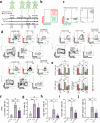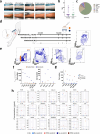This is a preprint.
Leveraging tissue-resident memory T cells for non-invasive immune monitoring via microneedle skin patches
- PMID: 40166546
- PMCID: PMC11957092
- DOI: 10.1101/2025.03.17.25324099
Leveraging tissue-resident memory T cells for non-invasive immune monitoring via microneedle skin patches
Abstract
Detecting antigen-specific lymphocytes is crucial for immune monitoring in the setting of vaccination, infectious disease, cancer, and autoimmunity. However, their low frequency and dispersed distribution across lymphoid organs, peripheral tissues, and blood pose challenges for reliable detection. To address this issue, we developed a strategy exploiting the functions of tissue-resident memory T cells (TRMs) to concentrate target circulating immune cells in the skin and then sample these cells non-invasively using a microneedle (MN) skin patch. TRMs were first induced at a selected skin site through initial sensitization with a selected antigen. Subsequently, these TRMs were restimulated by intradermal inoculation of a small quantity of the same antigen to trigger the "alarm" and immune recruitment functions of these cells, leading to accumulation of antigen-specific T cells from the circulation over several days. In mouse models of vaccination, we show that application of MN patches coated with an optimized hydrogel layer for cell and fluid sampling to this skin site allowed effective isolation of thousands of live antigen-specific lymphocytes as well as innate immune cells. In a human subject with allergic contact dermatitis, stimulation of TRMs with allergen followed by MN patch application allowed the recovery of diverse lymphocyte populations that were absent from untreated skin sites. These results suggest that TRM restimulation coupled with microneedle patch sampling can be used to obtain a window into both local and systemic antigen-specific immune cell populations in a noninvasive manner that could be readily applied to a wide range of disease or vaccination settings.
Conflict of interest statement
Competing interests S.J., P.T.H. and D.J.I. have submitted a patent application filed by MIT related to the data presented in this work. M.R. is principal or co-investigator of studies sponsored by Pfizer, Biogen, AbbVie, Incyte, LEO Pharma, Abeona Therapeutics, Dermavant, and Target RWE; and M.R. provides consulting for Pfizer, Biogen, Incyte, Takeda, Inzen, ROME Therapeutics, Almirall, Medicxi, Related Sciences, and VisualDx. The other authors declare no interests.
Figures





References
-
- Bacher P. & Scheffold A. Flow cytometric analysis of rare antigen specific T cells. Cytometry Pt A 83A, 692–701 (2013). - PubMed
Publication types
Grants and funding
LinkOut - more resources
Full Text Sources
